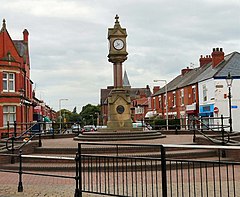Reddish
| Reddish | |
|---|---|
 Houldsworth Square in central Reddish |
|
| Reddish shown within Greater Manchester | |
| Area | 2.73 sq mi (7.1 km2) |
| Population | 28,052 (2011 Census) |
| • Density | 11,009/sq mi (4,251/km2) |
| OS grid reference | SJ893935 |
| • London | 159 mi (256 km) SE |
| Metropolitan borough |
|
| Metropolitan county | |
| Region | |
| Country | England |
| Sovereign state | United Kingdom |
| Post town | STOCKPORT, CHESHIRE |
| Postcode district | SK5 ! M19 |
| Dialling code | 0161 |
| Police | Greater Manchester |
| Fire | Greater Manchester |
| Ambulance | North West |
| EU Parliament | North West England |
| UK Parliament | |
Reddish is an area of the , in Greater Manchester, England. It is 2 miles (3.2 km) north of and 4.6 miles (7.4 km) southeast of Manchester. The population is 30,055 in an area of 7.08 square kilometres (2.73 mi²). By the UK Census 2011 the population of both wards (north and south) decreased to a combined total of 28,052.Historically a part of Lancashire, Reddish grew and developed rapidly during the Industrial Revolution and still retains landmarks from that period, such as Houldsworth Mill, a former textile mill.
Reddish Vale is a country park close to the locality.
Reddish is recorded as Redich (1205, 1212), Redych, Radich (1226), Radish, Rediche (1262), Redditch (1381), Redwyche, Radishe and Reddishe (16th century). The name either means "reedy ditch" (OE hrēod-dīc) or "red ditch" (OE rēad-dīc). Ekwall (1922) allows either form, stating "red" is less probable; Mills (1991) and Arrowsmith (1997) only give the "reed" option. The ditch referred to is possibly the Nico Ditch, an earthwork of uncertain origin bordering Reddish, Manchester and Denton. Folklore has it that the names Gorton and Reddish arose from a battle between Saxons and Danes. John Higson wrote in 1852
The neigh'ring trench is called the Nicker Ditch
Flowing with blood, it did the name convey
To th' bordering hamlet, Red-Ditch. Near here, Where
the last 'tween the foes was fought,
Where victory was won, that memorable
Eminence proudly was distinguished
By the name of Winning Hill. The streamlet
Aforemention'd gains appellation
Of Gore Brook, also the contiguous
Happy hamlet through which it floweth still
Bears, in glorious commemoration,
And e'er shall, the honour'd name of Gore Town.
Farrer and Brownbill dismiss this interpretation as "popular fancy".
Reddish does not appear in the Domesday survey; this is in common with most of the then southeast Lancashire area. A corn mill is known to have existed at the junction of Denton Brook and the River Tame from about 1400 onwards. The two main mediaeval houses were Reddish Hall at grid reference SJ899932 (demolished 1780, but visible on maps dated 1840) and Hulme Hall at grid reference SJ889926, later known as Broadstone, then Broadstone Hall (demolished 1945). The Reddish family were major landowners in the area from at least 1212 to 1613 when title passed by marriage to the Coke family. It passed down the family to Thomas Coke, 1st Earl of Leicester, who sold his land in Reddish at the end of the 18th century, and in 1808 it was bought by Robert Hyde Greg and John Greg. There were Hulmes in Reddish in the 13th century, and the land passed through the family until about 1700 when it was given to a charitable trust.
...
Wikipedia

